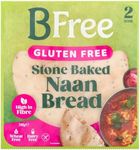Buying Guide for the Best Gluten Free Breads
Choosing the right gluten-free bread can be a bit overwhelming, especially with the variety of options available. Gluten-free breads are made without wheat, barley, rye, or any other gluten-containing grains, making them suitable for people with celiac disease or gluten sensitivity. When selecting gluten-free bread, it's important to consider several key factors to ensure you get a product that meets your dietary needs and preferences. Here are some important specifications to look for and how to navigate them.IngredientsThe ingredients list is crucial when choosing gluten-free bread. It should clearly state that the bread is made from gluten-free grains like rice, corn, quinoa, or sorghum. Avoid breads with artificial additives or preservatives, as they can affect the taste and nutritional value. If you have other dietary restrictions, look for breads that are also free from dairy, soy, or nuts. Your choice should align with your dietary needs and preferences.
TextureTexture is an important aspect of bread, as it affects the eating experience. Gluten-free breads can vary from soft and fluffy to dense and crumbly. If you prefer a bread that mimics traditional wheat bread, look for options that are described as soft and airy. For those who enjoy a heartier bread, denser varieties might be more appealing. Consider how you plan to use the bread—soft breads are great for sandwiches, while denser ones are better for toasting.
TasteTaste is subjective, but it's a key factor in enjoying your gluten-free bread. Some gluten-free breads have a neutral flavor, while others may have a distinct taste due to the type of grains used. If you're new to gluten-free bread, you might want to start with a mild-flavored option. If you enjoy experimenting, try breads with unique flavors like seeds or herbs. Your choice should reflect your personal taste preferences.
Nutritional ValueNutritional value is important for maintaining a balanced diet. Check the nutrition label for information on calories, fiber, protein, and sugar content. Gluten-free breads can sometimes be lower in fiber and protein compared to regular bread, so look for options that are fortified or made with nutrient-dense ingredients. If you're looking for a healthier option, choose bread with higher fiber and protein content to support your dietary goals.
Shelf LifeShelf life refers to how long the bread will stay fresh. Gluten-free breads often have a shorter shelf life than regular breads due to the absence of preservatives. If you don't consume bread quickly, look for options with a longer shelf life or consider freezing the bread to extend its usability. Your choice should depend on how frequently you eat bread and your storage preferences.
Brand ReputationBrand reputation can give you an idea of the quality and reliability of the gluten-free bread. Established brands with positive reviews are often a safer choice, as they have a track record of producing good products. Look for brands that are known for their gluten-free offerings and have certifications from reputable organizations. Your choice should be influenced by the trustworthiness and customer feedback of the brand.











